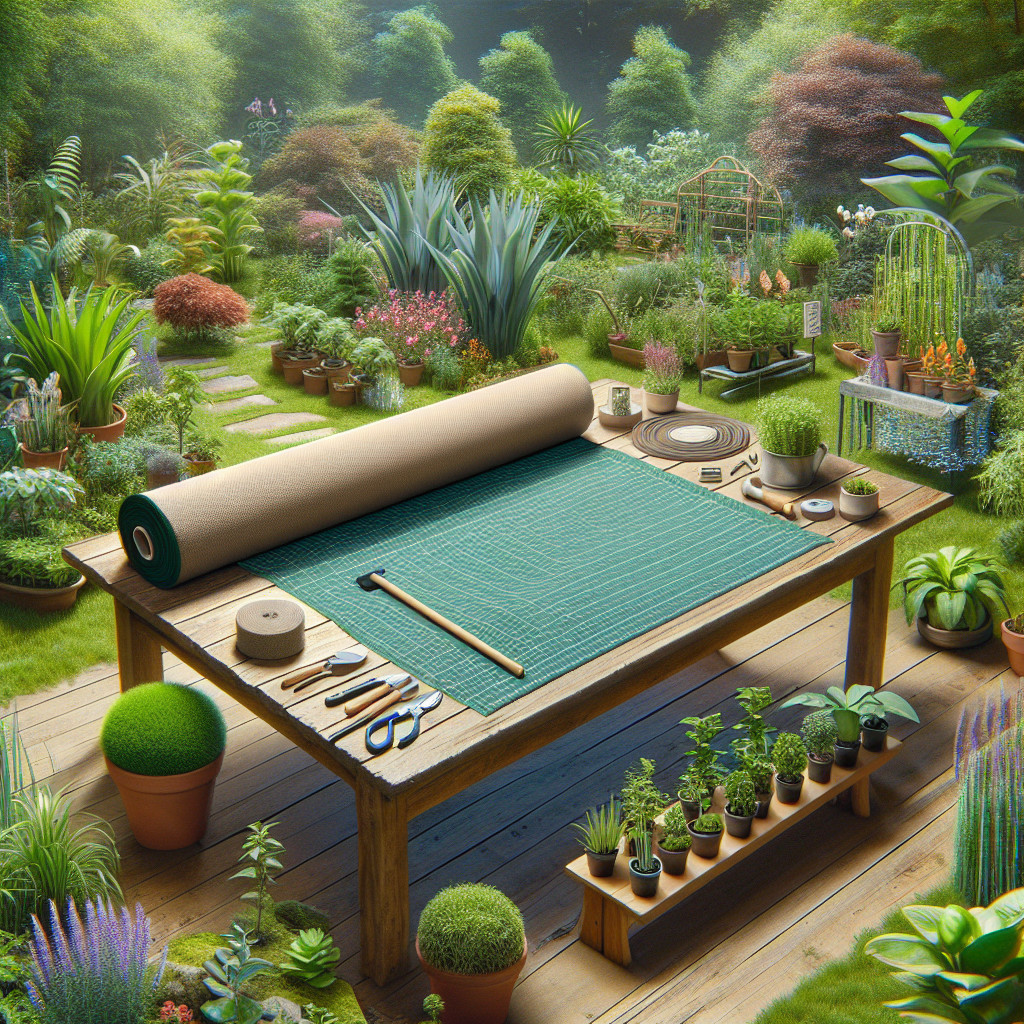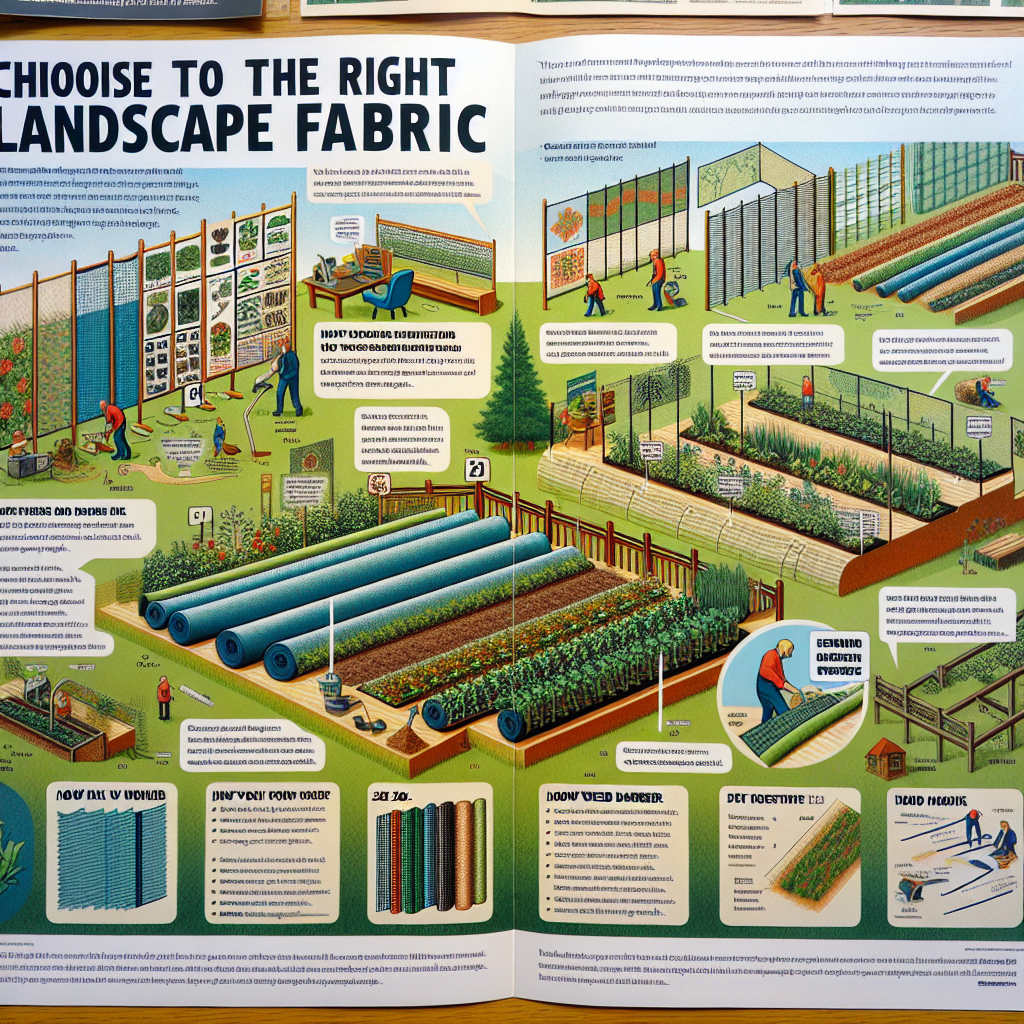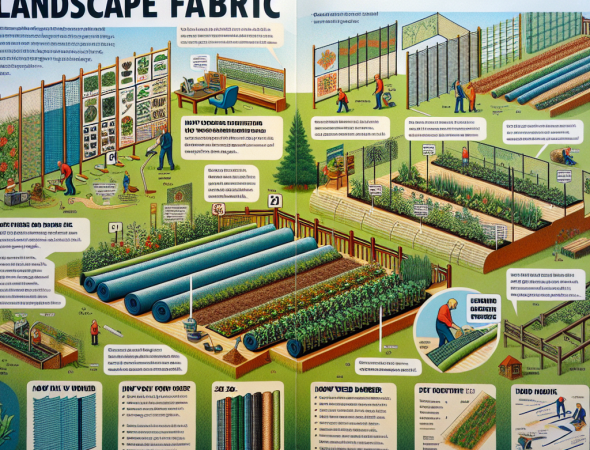2025 Landscape Fabric Buying Guide: How to Choose the Right Weed Barrier for Your Garden
Types of Landscape Fabric: Understanding Different Materials
When it comes to selecting the appropriate landscape fabric for your garden, understanding the various types of materials available is crucial. Landscape fabric serves as a weed barrier, preventing unwanted plants from overtaking your garden while allowing water, air, and nutrients to reach the soil. The effectiveness of this barrier largely depends on the material from which it is made, and each type has its own unique properties and applications.
One of the most common materials used in landscape fabric is woven polypropylene. This type of fabric is created by interlacing strands of polypropylene, resulting in a durable and strong barrier. Woven polypropylene is particularly effective at allowing water and nutrients to penetrate while simultaneously blocking sunlight, which is essential for weed growth. Additionally, its strength makes it suitable for areas with heavy foot traffic or where heavy mulch is applied. However, it is important to note that woven fabrics can sometimes allow smaller weed seeds to germinate through the fabric, necessitating regular monitoring and maintenance.
In contrast, non-woven landscape fabric is made from bonded fibers, which creates a more porous material. This type of fabric is often used in applications where drainage is a priority, as it allows for excellent water flow while still providing a barrier against weeds. Non-woven fabrics are typically lighter than their woven counterparts, making them easier to handle and install. However, they may not be as durable in high-traffic areas, and their ability to block sunlight can vary depending on the specific product. Therefore, when choosing non-woven fabric, it is essential to consider the specific needs of your garden and the level of foot traffic it will experience.
Another option to consider is biodegradable landscape fabric, which is made from natural materials such as jute or coir. This type of fabric is designed to break down over time, enriching the soil as it decomposes. Biodegradable fabrics are an excellent choice for organic gardening, as they align with sustainable practices and reduce the environmental impact of gardening. However, gardeners should be aware that these fabrics may not last as long as synthetic options, and their effectiveness as a weed barrier can diminish as they decompose. Consequently, they are best suited for short-term applications or for use in areas where long-term weed control is not a primary concern.
Furthermore, some landscape fabrics are specifically designed for particular applications, such as erosion control or landscaping on slopes. These specialized fabrics often feature additional properties, such as increased strength or enhanced drainage capabilities, making them ideal for specific gardening challenges. When selecting a fabric for these purposes, it is essential to consider the unique conditions of your garden and the specific challenges you may face.
In conclusion, understanding the different types of landscape fabric available is vital for making an informed decision that best suits your gardening needs. Whether you opt for woven polypropylene, non-woven materials, biodegradable options, or specialized fabrics, each type has its own advantages and limitations. By carefully evaluating the specific requirements of your garden, including factors such as drainage, foot traffic, and environmental impact, you can select the right weed barrier that will effectively support your gardening efforts while promoting a healthy and thriving landscape. Ultimately, the right choice will not only enhance the aesthetics of your garden but also contribute to its long-term health and sustainability.
Key Features to Consider When Selecting Weed Barriers

When selecting a weed barrier for your garden, it is essential to consider several key features that can significantly impact the effectiveness and longevity of the product. First and foremost, the material composition of the landscape fabric plays a crucial role in its performance. Common materials include polypropylene and polyester, both of which offer varying degrees of durability and permeability. Polypropylene is often favored for its strength and resistance to degradation from UV rays, making it suitable for long-term use in sunny environments. Conversely, polyester may provide a more cost-effective option, though it may not withstand the elements as effectively over time.
In addition to material, the weight of the fabric is another important factor to consider. Landscape fabrics are typically available in different weights, measured in ounces per square yard. Heavier fabrics tend to be more durable and resistant to tearing, which is particularly beneficial in high-traffic areas or gardens with heavy footfall. However, lighter fabrics can be easier to handle and install, making them a viable option for smaller gardens or less demanding applications. Therefore, it is crucial to assess the specific needs of your garden to determine the appropriate weight for your chosen weed barrier.
Another significant feature to evaluate is the permeability of the fabric. A good weed barrier should allow water, air, and nutrients to penetrate while effectively blocking sunlight to prevent weed growth. Some fabrics are designed with specific pore sizes that enhance their permeability, ensuring that essential elements reach the soil beneath. It is advisable to select a fabric that strikes a balance between weed prevention and soil health, as overly dense materials may hinder water and nutrient flow, ultimately affecting plant growth.
Furthermore, the ease of installation should not be overlooked when choosing a weed barrier. Some products come with pre-cut sizes or rolls that simplify the installation process, while others may require additional tools or materials for proper application. Additionally, consider whether the fabric is designed to be laid flat or if it has features such as stakes or pins to secure it in place. A user-friendly installation process can save time and effort, allowing you to focus on other aspects of your gardening project.
Moreover, the longevity of the weed barrier is a critical consideration. Some fabrics are designed for short-term use, while others can last several years, depending on their quality and the environmental conditions they are exposed to. It is wise to invest in a product that offers a warranty or guarantee, as this can provide peace of mind regarding its durability and performance over time. Additionally, consider the manufacturer’s reputation and customer reviews, as these can offer valuable insights into the product’s reliability and effectiveness.
Lastly, the cost of the weed barrier should be factored into your decision-making process. While it may be tempting to opt for the cheapest option available, it is essential to weigh the long-term benefits against the initial investment. A higher-quality fabric may save you money in the long run by reducing the need for frequent replacements and minimizing maintenance efforts. By carefully considering these key features—material composition, weight, permeability, ease of installation, longevity, and cost—you can make an informed decision that will enhance the health and aesthetics of your garden while effectively managing weed growth.
Installation Tips for Maximizing the Effectiveness of Landscape Fabric
When it comes to creating a thriving garden, the installation of landscape fabric is a crucial step that can significantly enhance the effectiveness of your weed barrier. To maximize the benefits of this gardening tool, it is essential to follow specific installation tips that ensure optimal performance. First and foremost, proper site preparation is vital. Before laying down the fabric, it is important to clear the area of any existing weeds, debris, and rocks. This not only provides a clean surface for the fabric but also prevents any potential growth that could compromise its effectiveness. Additionally, taking the time to level the ground can help in achieving a smooth installation, which is essential for preventing water pooling and ensuring proper drainage.
Once the area is prepared, the next step involves selecting the right type of landscape fabric. There are various options available, including woven and non-woven fabrics, each with its own set of advantages. Woven fabrics allow for water and nutrients to penetrate while blocking sunlight, making them ideal for perennial gardens. On the other hand, non-woven fabrics provide a more robust barrier against weeds but may require additional care to ensure adequate water flow. Therefore, understanding the specific needs of your garden will guide you in choosing the most suitable fabric.
After selecting the appropriate fabric, it is crucial to measure and cut it accurately to fit the designated area. When cutting the fabric, it is advisable to leave a few extra inches on each side to allow for overlap and secure anchoring. This extra material can be tucked under or secured with landscape staples, which will help keep the fabric in place and prevent it from shifting over time. Furthermore, when laying down the fabric, it is essential to ensure that the seams overlap by at least six inches. This overlap not only enhances the barrier against weeds but also minimizes the risk of gaps that could allow unwanted growth.
In addition to proper installation techniques, incorporating mulch on top of the landscape fabric can significantly enhance its effectiveness. Mulch serves multiple purposes; it not only adds aesthetic appeal to the garden but also provides additional protection against weeds, conserves moisture, and regulates soil temperature. When applying mulch, it is recommended to use organic materials such as wood chips or bark, as these will decompose over time and enrich the soil. A layer of two to three inches of mulch is generally sufficient to achieve these benefits while still allowing for adequate water penetration.
Moreover, regular maintenance is essential to ensure the longevity and effectiveness of the landscape fabric. Periodically checking for any signs of wear or damage will allow for timely repairs, which can prevent larger issues down the line. Additionally, monitoring the mulch layer is important, as it may need replenishing over time to maintain its effectiveness. By staying proactive in your garden maintenance, you can ensure that your landscape fabric continues to serve its purpose effectively.
In conclusion, the installation of landscape fabric is a critical component in creating a successful weed barrier for your garden. By following these installation tips, including proper site preparation, selecting the right fabric, ensuring accurate measurements, and incorporating mulch, you can maximize the effectiveness of your landscape fabric. With careful attention to detail and ongoing maintenance, your garden can flourish, free from the encroachment of weeds, allowing your plants to thrive in a healthy environment.








Add comment